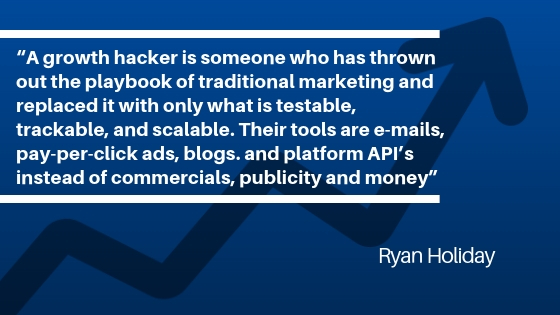Hello Guys, I am Avinash and today in this article I'll talk about some strategies to boost or scale-up your startup.
-Do you have any startup idea?
-Are you working on a startup?
-Do you already started a new startup?
So let's make it easier and let's discuss about how we together can change ourselves in super-humans and can scale-up our innovative idea like a rocket launcher.
What is Growth Hacking?
Growth hacking is a marketing technique that is experiment driven. It is used to figure out the most productive ways of growing a business. In this process, you would have to mix engineering, data, design, development, marketing, and analytics. And the main reason as to why it is called growth hacking is because the growth hacker would use these techniques and find the most innovative, cost-effective and rapid way of achieving growth instead of following the conventional processes.
The methods that the growth hacker uses to achieve the growth goal include reverse engineering, A/B testing, SEO, email marketing, viral marketing, and content marketing.
And the main formula that every growth hacker uses is —
Product + Growth = Impact
Now that you are clear about what the growth hacking is all about, let us move ahead and talk about the growth strategies that can help you prepare your business for 2019.
Who is a Growth Hacker?
A growth hacker is someone who is clever, original, and innovative. Their primary goal is to implement creative, cost-effective strategies to ensure businesses are able to acquire and retain customers for as long as they can.

1. Analyse yourself:
Use these question to guide what kind of business you want to start. What need does your startup address? Why will people care? If you can answer these two major questions you’re already well on your way to success.
Once you have the reason, start asking yourself even more questions to help you figure out the type of business you should start, and if you have what it takes.
- What skills do you have?
- Where does your passion lie?
- Where is your area of expertise?
- How much can you afford to spend, knowing that most businesses fail?
- How much capital do you need?
- What sort of lifestyle do you want to live?
- Are you even ready to be an entrepreneur?
2. Know Your Competition :
- Who are your competitors?
- What you need to know about your competitors
- Learning about your competitors
- Hearing about your competitors
- How to act on the competitor information you get
Direct Competitors
Direct competitors are businesses that have the same product or service offerings. For example, if you’re a landscaping company, your direct competitors are other landscapers. Information on your direct competitors will facilitate your ability to stand out above them.
Indirect Competitors
Indirect competitors are those who don’t offer the same service, but meet the same need in an alternative way. In the landscaping example, your indirect competitors would be businesses that facilitate do-it-yourself lawn care, like local nurseries, home improvement centers, and hardware stores. Information about your indirect competitors will help you to find effective ways of getting in front of your target audience.
3. Leverage Referral Marketing:
Referrals have always been the main way of growing a business for decades now. A referral from a family member, friend, or even from any of the industry influencers would convert a lead much faster than you can think of. The cost of getting referrals isn’t much and this would allow you to reduce the costs that you are putting into your company growth strategies.

4. Build a Social Media Community Around Your Brand/Product:
Social media platforms are the most popular ones in the world currently. It is a place where almost everyone is there on. And this makes social media an important part of the marketing strategy for any startup. In short, you can easily leverage social media and promote all about your company, get market feedback and also interact with all the industry influencers.
Social media Statics :
- Total worldwide population as 2015 is 7.3 billion.
- Total internet users - 3.17 billion
- Total active social media users - 2.3 billion
- 91% of retails brands use 2 or more social media accounts.
- Internet users have an average of 5.54 social media accounts.
- Social media users have risen by 176 million in last year.
- 1 million active social users joins everyday, 12 people joins each second.
- There are 1.65 billion active social media accounts globally.
- Set Your Goal :
Before starting with social media you should define your goal, what you want to achieve from social media for your beneficiaries. Because we all know that without any aim or goal we can't reach to our target.
Let's take a look at some goals which everyone wants to achieve :-
- Sales
- Brand Awareness
- Drive traffic to Your website or blog
- Want more followers or likes
- Customer loyalty
In the beginning just select one of these and built your strategy to achieve that. After start getting some progress with your initial goal and have real measurable result, you can select another goal from the list.
- Choose Relevant Social Media Network :
Choose Relevant social media platform according to your comfort. Each social media network have its own unique features and functionality with a unique impact.
Mr. Tim Grahl tells us about three big questions to ask yourself when choosing a social network :-
- Does it make sense for me?
- Does is make sense for my content?
- Do potential fans spend time there?

Let's take a look at answers about some social media networks, Why should we use them? :-
- Why Facebook :
The biggest and the largest social media network. More than 70% adults actively use facebook, So this is much enough to use facebook for your business.
But also keep in mind that with great popularity comes great competition. There are much crowd on facebook to make you disappear or popular.
- Why Twitter :
Twitter is so smart, mostly crowd on twitter is younger. You can get here wide variety of of technology, news, sports, marketing, journalism, and so on.
- Why LinkedIn :
This is a business oriented social media platform. This is a great place for professionals, Best platform for B2B companies. But B2C companies are still struggling.
- Why Instagram :
Great place for fashion and photo sharing. Instagram works great in paring with facebook and twitter. mostly brands have been starting using Instagram.

Post a Comment